Herein you’ll find articles on a very wide variety of topics about technology in the consumer space (mostly) and items of personal interest to me. I have also participated in and created several podcasts most notably Pragmatic and Causality and all of my podcasts can be found at The Engineered Network.
No Finger Waving Please. No I Told You So.
First there was the iPhone and Apple said that its mobile browser would not support Adobe Flash. There was an uproar, an outcry, a sense of disbelief that Apple could possibly turn its back on something so fundamental to the web experience at the time. After all, Flash had been around for a while before Adobe bought it and was popular amongst developers as it was a relatively high-level language with readily available tools and an ever growing developer base. Adobe had developed flash plug-ins for pretty much every browser conceivable and several highly notable video on demand providers used it as a wrapper around their video content for DRM purposes. The fact was that Flash was very popular and the vast majority of sites on the web used it in one way or another.
Apple came under increasing pressure from Google Android, RIM BlackBerry and a campaign from Adobe pushed Apple (after a few years) to finally state their case for not using Flash. Steve Jobs wrote an open letter he called “Thoughts On Flash” that stated Apples rationale behind not incorporating Flash support on Apples iOS devices. There were still some critics but the reasons for Apples exclusion were finally officially admitted - Apple could put a H.264 chip in their products to reduce the overhead on their mobile CPUs and process video at significantly lower power and they could do this because they knew that H.264 was an open standard and could not be changed on a whim. Investment in Flash in the same way was a major risk and hence the Flash plug in would need to remain a software solution forcing the CPU to take the burden of running the intensive Flash software, sucking battery life and reducing the performance on their devices.
Apple weren’t stupid - they knew how Flash worked and they knew that customised chips (ASICs as they are called in the industry) that run Flash were difficult to power optimise and were few and far between - all subject to change without notice. They knew that Flash sucked significant CPU time on the Desktop/Laptop and that no matter what Adobe did the architecture was simply not designed to be low-power. When you architect products generally (though not in every case) the higher the level of the language (and the easier for developers to write code in) the more of the heavy lifting the operating system MUST do to perform the required task. The most efficient code is machine assembly code - it runs very fast but at a cost - the programmer must understand every interrupt, precise time delays and so on to ensure the code will work and it’s not written in plain english. MOV AX,BX isn’t exactly obvious as to what that means.
I’m digressing. The point is that Flash was never going to scale down to low-powered devices and time and again Adobe released mobile flash versions for different platforms and each time there were limitations compared to the desktop version - some features were incredibly slow or just didn’t work. Apple understood this would be a problem and well before 2007 they decided not to accommodate Flash in their iOS devices. Around that time they also took a step in their Desktop safari web browser to compartmentalise the flash browser plug in such that if/when it crashed, it wouldn’t take the browser and operating system with it. They were distancing themselves from Flash on both platforms.
Fast forward to this week. Adobe announced that it was ceasing development on Mobile Flash in a statement on their website. The language wasn’t the most elegant, but finally Adobe have seen the same writing on the wall that Apple saw over 5 years earlier. Flash is a great, easy to program, high-level development language. Unfortunately it will always be a CPU-intensive product that is single-threaded (i.e. it can not use multiple CPU cores as efficiently like HTML5 - refer Web Workers) and will have limited performance on lower powered devices. With the latest moves on the desktop towards multiple CPU cores at slower speeds, Flash will continue to become more sluggish as it can’t use those extra cores effectively. Within a few years Adobe will silently stop working on Flash altogether - desktop and mobile. They will focus on refining their developer tools for HTML5 and make them best in the industry - as perhaps they should have in the first place.
I don’t want any finger waving. Please, no I told you so’s from the Apple fan elite either. This saga to me has been more about corporate pride on Adobes part - having acquired a product that was popular but inevitably had more limited life than they wanted to admit. It’s natural that products and platforms are born, shine for a time and then blink or fade out of the mainstream. That’s normal and that’s healthy. Flash had its time in the sun, and has added to the body of knowledge that is web technology. It’s time to move on.
So long, and thanks for all the Flash.
Apple and the AppleTV and Apple TVs
Much has been written lately based on Steve Jobs quote from his biography that he had “finally cracked it” – referring to solving the problem of how to make a better TV set. Stock prices have gone up and countless analysts and pundits have put forward their thoughts on the subject. Now it’s my turn.
Almost every house has a television in the western world. There are a lot of houses and that means there are a lot of televisions. Then again it’s an old market that is already quite saturated. Many of the worlds largest electronics companies make television sets including (but not limited to) Sony, Samsung, LG, Hitatchi, Palsonic, Conia to name just a few. The next problem is, unlike PCs and Mobile Phones people don’t buy televisions very often at all. Often they will use the same television for as long as 10 years before buying a new one. Competition makes margins slimmer and innovations regularly copied.
To break into this market Apple will need three things: an innovation that only they can provide (and is difficult to copy quickly), patience (lots and lots of patience) and commitment. Of course any Apple television will have high build quality, be very likely thin, light and relatively free from buttons and likely sporting a manufacturing technique that competitors will have trouble matching. This will differentiate their hardware, but this is not the only innovation they will need to succeed. The content must also take a step up from what the AppleTV currently provides – more movies, more live sports (that can be subscribed to via Apple/iTunes naturally) and more on-demand news. The television must also support all existing technologies – doubtless by a dozen or so legacy adaptors sold separately. Finally a new interface that does away with the clumsy square that is moved around the screen by a glorified D-Pad on the AppleTV. Instead a simple remote with a microphone built in and possibly only one button on it. Siri or its descendent will take your verbal commands to control the television. Expect the AppleTV to get this feature in the next 12 months as a trial run from the main event.
These three things put together will make the Apple television innovative in a way that competitors will find difficult to match. In the same way that Apple has taken technologies it perfected in its existing products and then used them to create the iPhone, Macbook Air and iPad, so they will bring them together into an Apple television. It’s the next logical, and frankly, obvious step.
It will not sell as well as the iPhone. It will not sell as well as Macs or iPads. It will sell slowly, but surely, increasing in sales volume with time. There will be naysers, pundits that criticize their attempts, and the stock will probably suffer in the short term. Apple need to be in it for the long term.
Apple will not dominate the television market for a very long time – if ever. Breaking into this market will require dogged determination and huge financial resources. If anyone was to do break into the television market and push the technology forward however, Apple would be the one to watch.
Apple and Siri - Two Sides of a Coin
With the iPhone 4S Apple introduced Siri - your own personal digital assistant to help you with common day to day tasks through an interactive voice interface. I’ve been playing with Siri for a while now and think it’s safe to say without any doubt that there are two distinct ways to interact with Siri. On the one side there’s the useful bit: Ask Siri to make an appointment for you, a meeting, a note, play some specific song or artist, set a reminder for when you get home or dictate brief text messages (not a comprehensive list). Then, on the other side of the coin there’s the part that makes it a bit of a toy: Ask Siri any ridiculous question you can think of and see what it says back to you.
In the serious way Siri is quite excellent when compared to Apples Voice Control that debuted with the iPhone 3GS running iOS3. For example asking Voice Control to “Play a song by Matchbox Twenty” would not work, but asking “Play a song by Matchbox Two-Zero” would find the right music just fine; whereas Siri gets both right, each time. The word recognition is superior and there is obvious tweaking to the pattern matching like my example - numbers and combination numbers - however Siri also accepts “I want to listen to Matchbox Twenty” where the previous Voice Control would draw a blank. The true leap forward however is the break from keyword based instructional commands to flowing conversation with context. This is most clear when making a reminder for example: Me: “Remind me to wake up”, Siri: ‘When would you like me to remind you?’ Me: “6 AM” Siri: ‘Okay I can add this to your reminders. Shall I go ahead?’ Me: “Move it to 7 AM” Siri: ‘Here’s your reminder for tomorrow at 7AM. Shall I create it?’ Me: “OK” Siri: ‘Okay, I’ll remind you.’
There are a few variants of the responses as I made the reminders example above - sometimes Siri responds with ‘…I can add this…’ and others ‘Here’s your reminder…’ and this tries to maintain an illusion that you’re not talking to a machine by switching things up. Of course Apple needn’t have cared, it still would have been just as useful with the same responses every time, but Apple clearly wanted to take this another step and not only allow the user to speak a multitude of requests, but to also respond in a multitude of ways. Inevitably however there are only so many ways in which Siri can respond. Time and careful attention to what you say and what the response is, for the keen observer at least, shows up clearly that it’s just a machine programmed by people and the “AI” part of it is perhaps stretching things. As an engineer, I look at Artificial Intelligence as neural networks combined with some fuzzy logic and machines that truly can learn. Siri certainly learns basic things, like who your partner or children or parents are (you tell Siri once, it remembers) but so far as deductive reasoning goes it’s not as intelligent as it might seem.
That said, it is fun and convenient to use. The fun part is clearly asking Siri all sorts of unusual questions. Below are some examples with Siris responses.

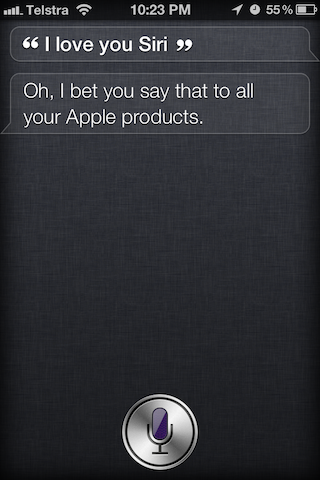
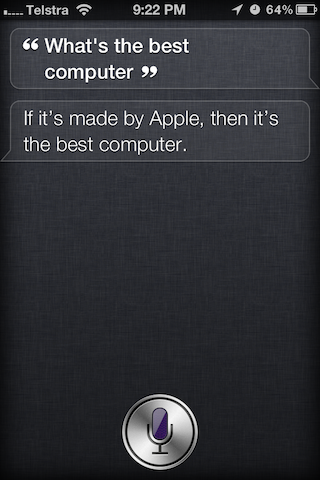

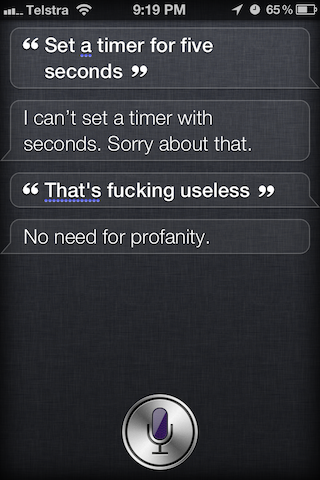
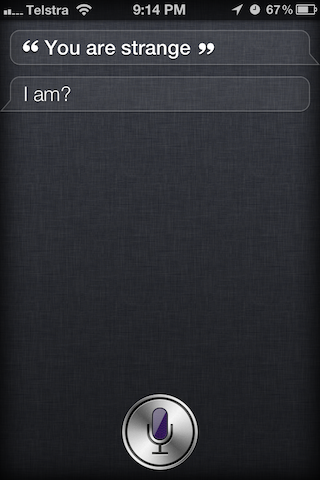
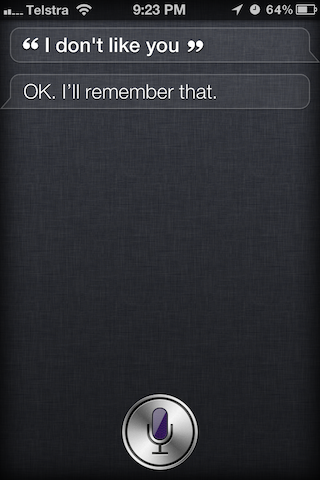
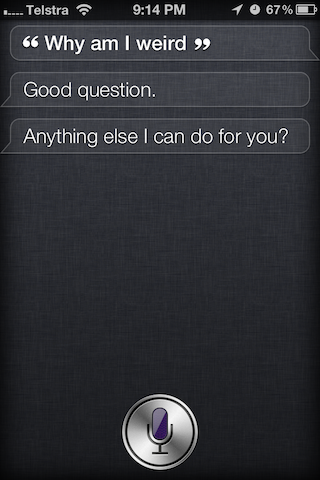
It becomes a pastime as you try more and more phrases, political and science-fiction references, anything that comes to mind - just to see what Siri will respond with. The responses you get have a bit of a slant to them - an edge of impatience even. The programmers were obviously keen to make it feel like a slightly annoyed personal assistant and they’ve generally succeeded if that was their goal. In a brief fit of frustration at one point I did nothing but spout expletives at Siri. Siri’s response: Nothing. It simply turned itself off as if you’d hit the microphone button to cancel your input. I suppose this is their way of putting virtual fingers in Siri’s virtual ears.
The software is currently advertised by Apple as being in Beta, so there is no doubt they will add more features, more responses and more attitude perhaps. Even at the moment, it is perhaps the best implementation so far (that I’ve used) for a voice interface to a digital device.
Farewell Steve Jobs
When I first started to gain an interest in Apple in 2006, I began to frequent the Australian MacWorld forums. A topic came up regarding Steve Jobs (I’d link to the post but it seems to have vanished) and how pivotal Steve was to the success of Apple. I commented along the lines of, “he’s just another CEO”. The then editor of MacWorld Mr Matthew JC Powell corrected me that no, Steve Jobs was something more than just a CEO. At that point I shrugged it off as simply Matthew being an Apple and Steve Jobs fan to the core, and stuck to my initial belief.
The problem was as time passed and I began to see more and more of Steve, both in current events and delving back into the past keynotes and addresses Steve had given (even some rare interviews), I began to realise that I had been wrong about Steve. He wasn’t your ordinary CEO. This man engaged his end customers directly from time to time. This man made decisions about fine details of the companys products. This man had a clear vision for BOTH the company and its products far into the distant future. This man was humble enough to kill off his own ideas if they weren’t working out. Not a typical, egotistical, politically and career driven CEO that I have met, dealt with and observed in the past. Not someone that just had meetings to discuss vision statements. He was a truly inspirational and heavily involved leader.
I believe that everyone has the potential to bring something new and special to the table, for the benefit of their friends, their family and their work. Steve had so many good things he brought to those of us who were listening. I will not list them. Instead I will list two of his axioms that I have taken on board in my personal and professional life. The two big ones that I learned from him:
“People think focus means saying yes to the thing you’ve got to focus on. But that’s not what it means at all. It means saying no to the hundred other good ideas that there are. You have to pick carefully.”
“The best ideas have to win, otherwise you don’t have good people who stay.”
These ideas mean more to me than the Mac Pro I’m typing this on, or the iPad that I love to use. Those things are just the materialisations of his ideas and principles.
I will miss Steve Jobs.